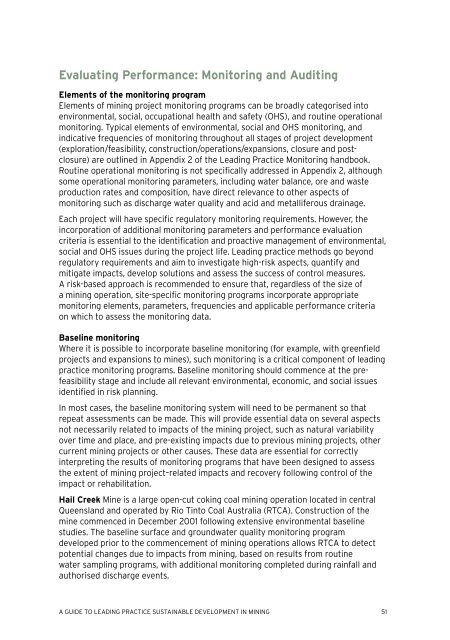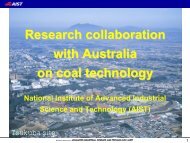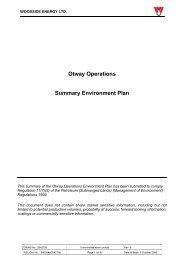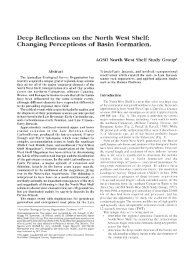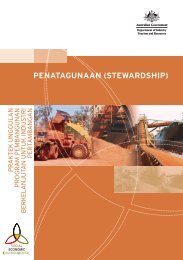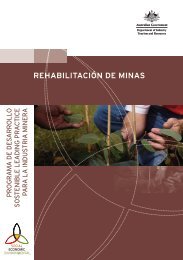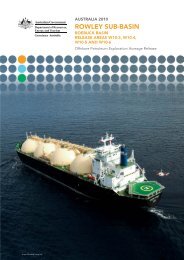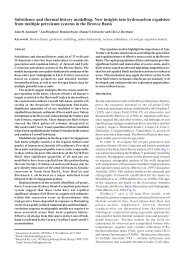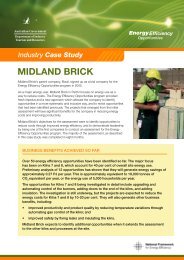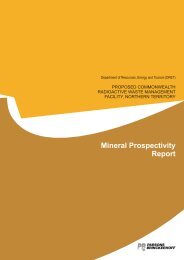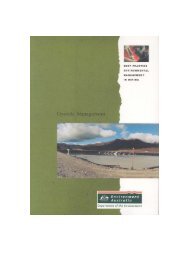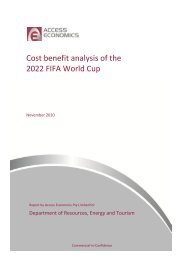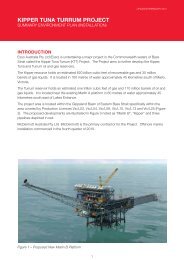A guide to leading practice sustainable development in mining
A guide to leading practice sustainable development in mining
A guide to leading practice sustainable development in mining
You also want an ePaper? Increase the reach of your titles
YUMPU automatically turns print PDFs into web optimized ePapers that Google loves.
Evaluat<strong>in</strong>g Performance: Moni<strong>to</strong>r<strong>in</strong>g and Audit<strong>in</strong>g<br />
Elements of the moni<strong>to</strong>r<strong>in</strong>g program<br />
Elements of m<strong>in</strong><strong>in</strong>g project moni<strong>to</strong>r<strong>in</strong>g programs can be broadly categorised <strong>in</strong><strong>to</strong><br />
environmental, social, occupational health and safety (OHS), and rout<strong>in</strong>e operational<br />
moni<strong>to</strong>r<strong>in</strong>g. Typical elements of environmental, social and OHS moni<strong>to</strong>r<strong>in</strong>g, and<br />
<strong>in</strong>dicative frequencies of moni<strong>to</strong>r<strong>in</strong>g throughout all stages of project <strong>development</strong><br />
(exploration/feasibility, construction/operations/expansions, closure and postclosure)<br />
are outl<strong>in</strong>ed <strong>in</strong> Appendix 2 of the Lead<strong>in</strong>g Practice Moni<strong>to</strong>r<strong>in</strong>g handbook.<br />
Rout<strong>in</strong>e operational moni<strong>to</strong>r<strong>in</strong>g is not specifically addressed <strong>in</strong> Appendix 2, although<br />
some operational moni<strong>to</strong>r<strong>in</strong>g parameters, <strong>in</strong>clud<strong>in</strong>g water balance, ore and waste<br />
production rates and composition, have direct relevance <strong>to</strong> other aspects of<br />
moni<strong>to</strong>r<strong>in</strong>g such as discharge water quality and acid and metalliferous dra<strong>in</strong>age.<br />
Each project will have specific regula<strong>to</strong>ry moni<strong>to</strong>r<strong>in</strong>g requirements. However, the<br />
<strong>in</strong>corporation of additional moni<strong>to</strong>r<strong>in</strong>g parameters and performance evaluation<br />
criteria is essential <strong>to</strong> the identification and proactive management of environmental,<br />
social and OHS issues dur<strong>in</strong>g the project life. Lead<strong>in</strong>g <strong>practice</strong> methods go beyond<br />
regula<strong>to</strong>ry requirements and aim <strong>to</strong> <strong>in</strong>vestigate high-risk aspects, quantify and<br />
mitigate impacts, develop solutions and assess the success of control measures.<br />
A risk-based approach is recommended <strong>to</strong> ensure that, regardless of the size of<br />
a m<strong>in</strong><strong>in</strong>g operation, site-specific moni<strong>to</strong>r<strong>in</strong>g programs <strong>in</strong>corporate appropriate<br />
moni<strong>to</strong>r<strong>in</strong>g elements, parameters, frequencies and applicable performance criteria<br />
on which <strong>to</strong> assess the moni<strong>to</strong>r<strong>in</strong>g data.<br />
Basel<strong>in</strong>e moni<strong>to</strong>r<strong>in</strong>g<br />
Where it is possible <strong>to</strong> <strong>in</strong>corporate basel<strong>in</strong>e moni<strong>to</strong>r<strong>in</strong>g (for example, with greenfield<br />
projects and expansions <strong>to</strong> m<strong>in</strong>es), such moni<strong>to</strong>r<strong>in</strong>g is a critical component of <strong>lead<strong>in</strong>g</strong><br />
<strong>practice</strong> moni<strong>to</strong>r<strong>in</strong>g programs. Basel<strong>in</strong>e moni<strong>to</strong>r<strong>in</strong>g should commence at the prefeasibility<br />
stage and <strong>in</strong>clude all relevant environmental, economic, and social issues<br />
identified <strong>in</strong> risk plann<strong>in</strong>g.<br />
In most cases, the basel<strong>in</strong>e moni<strong>to</strong>r<strong>in</strong>g system will need <strong>to</strong> be permanent so that<br />
repeat assessments can be made. This will provide essential data on several aspects<br />
not necessarily related <strong>to</strong> impacts of the m<strong>in</strong><strong>in</strong>g project, such as natural variability<br />
over time and place, and pre-exist<strong>in</strong>g impacts due <strong>to</strong> previous m<strong>in</strong><strong>in</strong>g projects, other<br />
current m<strong>in</strong><strong>in</strong>g projects or other causes. These data are essential for correctly<br />
<strong>in</strong>terpret<strong>in</strong>g the results of moni<strong>to</strong>r<strong>in</strong>g programs that have been designed <strong>to</strong> assess<br />
the extent of m<strong>in</strong><strong>in</strong>g project–related impacts and recovery follow<strong>in</strong>g control of the<br />
impact or rehabilitation.<br />
Hail Creek M<strong>in</strong>e is a large open-cut cok<strong>in</strong>g coal m<strong>in</strong><strong>in</strong>g operation located <strong>in</strong> central<br />
Queensland and operated by Rio T<strong>in</strong><strong>to</strong> Coal Australia (RTCA). Construction of the<br />
m<strong>in</strong>e commenced <strong>in</strong> December 2001 follow<strong>in</strong>g extensive environmental basel<strong>in</strong>e<br />
studies. The basel<strong>in</strong>e surface and groundwater quality moni<strong>to</strong>r<strong>in</strong>g program<br />
developed prior <strong>to</strong> the commencement of m<strong>in</strong><strong>in</strong>g operations allows RTCA <strong>to</strong> detect<br />
potential changes due <strong>to</strong> impacts from m<strong>in</strong><strong>in</strong>g, based on results from rout<strong>in</strong>e<br />
water sampl<strong>in</strong>g programs, with additional moni<strong>to</strong>r<strong>in</strong>g completed dur<strong>in</strong>g ra<strong>in</strong>fall and<br />
authorised discharge events.<br />
A GUIDE TO LEADING PRACTICE SUSTAINABLE DEVELOPMENT IN MINING 51


